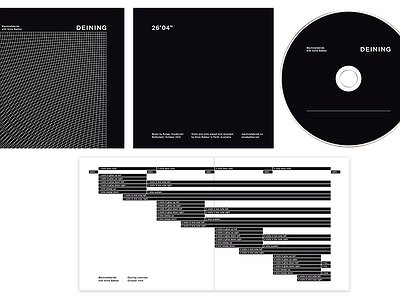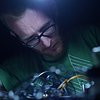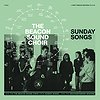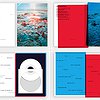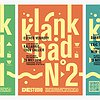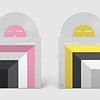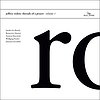Could you take us through a day in your life, from a possible morning routine through to your work? Do you have a fixed schedule? How do music and other aspects of your life feed back into each other - do you separate them or instead try to make them blend seamlessly?
I am quite disciplined, so I work on office hours. Some days of the week I even get up around 6:00 (‘cause of my wife’s work) … these are the most productive.
But as mentioned, I’m a musician as well. Actually, that’s my main occupation. So my days are a mix go graphic work and doing music, with a fluctuating balance. During the day, I’ll get out to do groceries, or do some domestic things (cleaning, washing, etc) as a nice distraction from the work.
Could you describe your creative process on the basis of a piece or album that's particularly dear to you, please? Where did the ideas come from, how were they transformed in your mind, what did you start with and how do you refine these beginnings into the finished work of art?
I’m picking one of my own releases … ‘Deining’, with Anne Bakker. It’s a piece of music that is essentially very simple, but sounds really complex. That duality is something I wanted to have in the artwork too. I had a vague idea in my head … of something that looked straight and simple, but on second glance seems to be weirdly morphed. I was experimenting in (software program) Illustrator when I sort of accidentally found the ‘solution’ that became the ‘Deining’ sleeve.
There are many descriptions of the ideal state of mind for being creative. What is it like for you? What supports this ideal state of mind and what are distractions? Are there strategies to enter into this state more easily?
I might feel uncreative when I’m bored, but as soon there’s something I can work on, that disappears. I don’t think there’s a particular state … maybe therefore my work isn’t ‘emotionally demanding’ to do? Must say that it’s easier than doing music. At least, there are less ‘writer’s block’-kinda moments.
Do you tend to listen to the music in question a lot or at all while working on the project? Is your approach more guided by the emotions or ideas stirred by the music or conceptual considerations?
Sometimes I listen to the music while working on the design, and I think that helps. But a lot of the work I do is for people who’s music I already know, for labels that are familiar to me, so that sort of dictates or inspires the direction it will go to. When I start from scratch, a lot of decisions are made impulsively (so emotional), but from there on it quickly becomes something more mathematical … aligning things, balancing stuff, adjusting spacing, and stuff that most people won’t even notice … This fine tuning, by the way, is specifically an aspect I see in my musical work as well … this working on details until the balance is right. Definitely one of my favourites parts of the process.
What kind of materials have proven to be particularly effective to work with? Do you maintain an archive of materials for potential use in future projects? If so, what does it consist of and what are your criteria for adding something to it?
If you mean actual physical material, I’d go for paper. I just love paper. I just really like old-fashioned printed stuff. But if you mean materials as in images or shapes … years and years ago I’ve made a bunch of scans of bad black and white xerox copies, really grainy. I’ve been using these for many many times to create textures in designs. To have something ‘dirty’ within the rigidness.
Our sense of hearing shares intriguing connections to other senses. From your experience, what are some of the most inspiring overlaps between different senses - and what do they tell us about the way our senses work? What happens to sound at its outermost borders?
Wow, that’s a difficult question. Not sure how the ‘outermost borders of sound’ relate to graphic design. But this question does remind me of a project I recently worked on, which was quite an experience for the ears, eyes, mind and stomach … I did the music for a virtual reality film by Memo Akten, which was based on the phenomena that happens when both eyes see something different (the mind mixes the two images randomly). That, within a super abstract 3d environment, caused quite a trip. It’s amazing that you really feel it in your stomach when the camera makes a dive … your body isn’t moving at all, but you still get that same sensation. And then there was my sound, which was spatialised, so it changed when you looked around (with the Oculus Rift). I always said that I’m ‘creating spaces’ with my music, and this brought it a step closer to that idea.
Art can be a purpose in its own right, but it can also directly feed back into everyday life, take on a social and political role and lead to more engagement. Can you describe your approach to art and being an artist?
To be honest, I wouldn’t describe (my) graphic design as an art-form. It’s not autonomous in a strict sense; there’s information that needs to be transmitted, and for a big part the music dictates the design. So it’s completely different than a sculpture or painting. And well, as a graphic designer (an ‘applied artist’?), I don’t think my graphic work has much of a political role. I think my music (which is more of an autonomous way of expressing for me) might be more interesting in that respect, but I’m glad this interview is about my visual work ;-)
It is remarkable, in a way, that we have arrived in the 21st century with the basic concept of music design still intact. Do you have a vision of it, an idea of what it could be beyond its current form?
Ultimately, it’ll move more and more into the digital realm. While I’m still very much working in the ‘old school way’. Albums are already becoming audio/visual experiences (Beyonce’s ‘Lemonade’), and I’m sure that our music experience will change with the gadgets that will be invented in the future. The cool thing is that different types of media (video, 3d, sound, multi-sensory, illustration) are being mixed more and more. It’s already changing. But in a decade or so, the possibilities are probably going to be wild.

